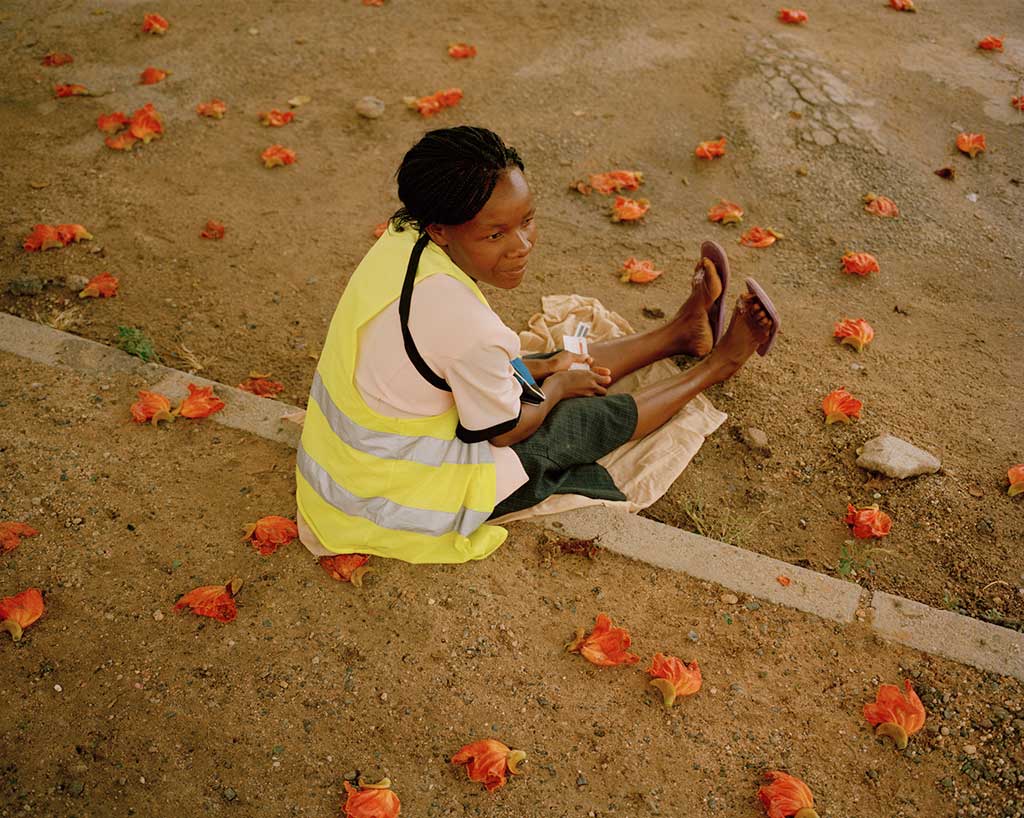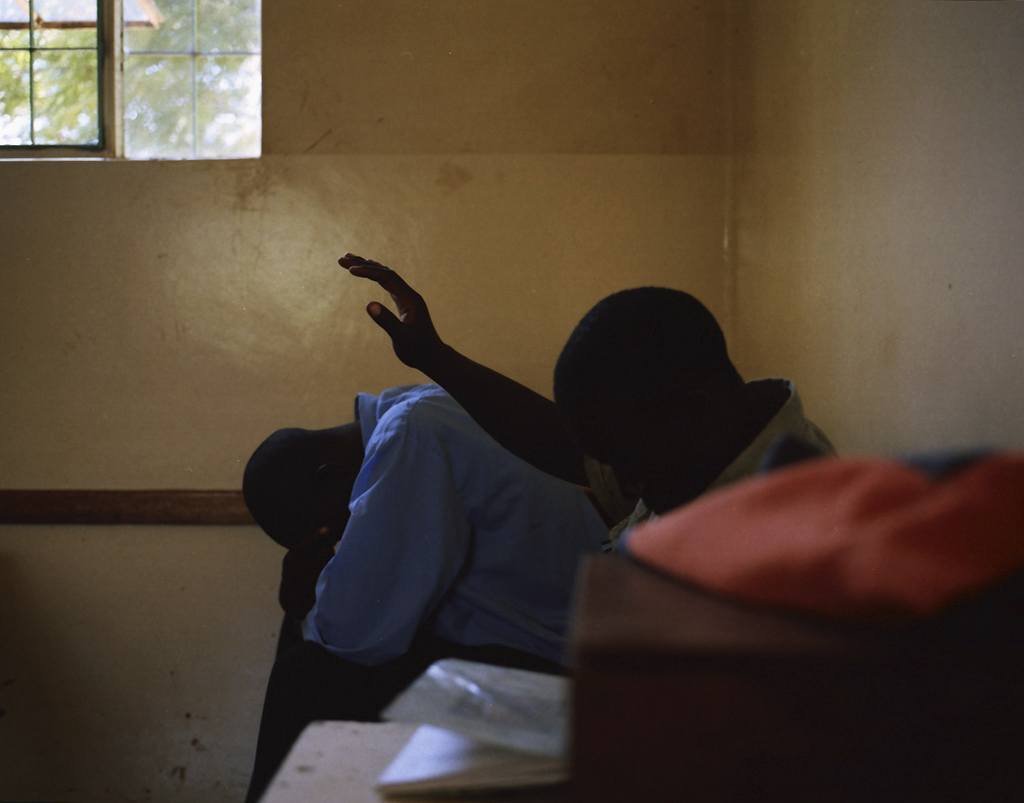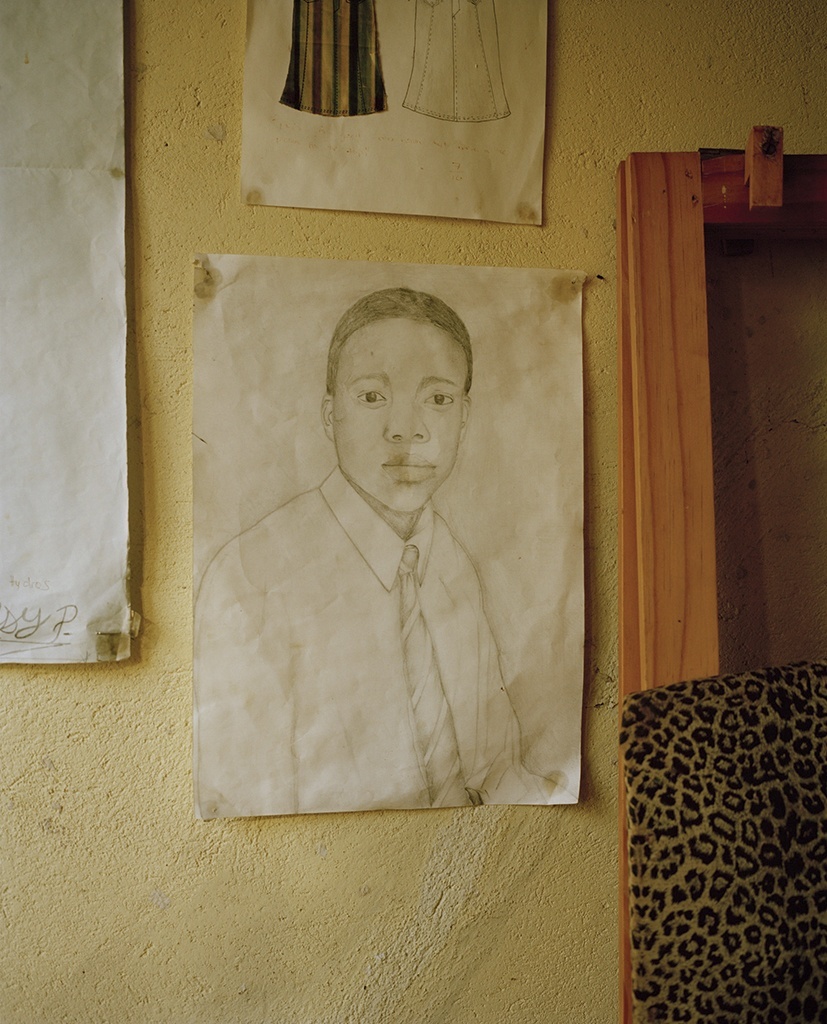The National Herbarium of Zimbabwe is a moderate stretch of city-bound grassland dotted with locked and abandoned facilities—a tea room, toilets, a rusting sign pointing to Desert Plants—and with gestural stone sculptures that hold their poses like chameleons. At the entrance is a small booth in which three people are sitting listening to a radio and talking in Shona. When he gestures to enter, the woman of the three, who appears to be the guest but draws obvious power around her thick, seated form, says to him, You pay, and leaves it at that. Their easy conversation has stopped. They examine him more with insolent curiosity than suspicion as he makes up his mind, the most absurd moment coming (for all of them) when he silently hands over a worn two dollar bill as payment to enter this neglected patch of land on the outskirts of a city where a month’s rent can cost eight.
A café from a different era sits packed up behind rusting gates so he takes a seat under an exterior edge of thatched roof and fixes a sandwich. In the distance, an egret sulks its way past some bushes. The view softens when a cloud floats in front of the sun; it happens every few minutes, fading out and fading in, a kind of breathing, the way low waves in the evening can remind one of heavy lungs. Half an hour later, a man in gum boots strides along the same horizon with the loose-limbed cadence of a labourer. Two birds that have been echoing each other’s calls have stopped. It could be evening but for the missing colour, the inevitability, of dusk.

After lunch he walks out of the Herbarium—the booth is now unmanned—and takes a turn down a long stretch of road without houses. Eventually he comes upon a trench being dug alongside the pavement. Piles of the reddest earth have been loaded to one side, richer and deeper in colour than brick; he presses it between two fingers and the stain will not come away. Further down the road he comes upon a vast white house behind tall walls. There are surveillance cameras along the length of the compound, and he tries to ask a man walking nervously past him what the building is but the man shakes his head and refuses to stop. He begins to ask the next passerby but with eyes fixed on the ground this man just yells at him. Don’t ask questions! Just keep walking!
He has already guessed at whose house it must be but by this time it’s too late. A grey-uniformed man with a machine gun held to his side trots out of the compound gates and speaks a few words to an armed soldier. The soldier, a short, helmeted figure in fatigues, featureless under the clear afternoon sun, then gestures for him to cross the street. The first remarkable fact about the soldier is the ease of his actions, swinging his rifle into one hand and waving him forward in one practiced movement. Close-up, he has the hard, cubist features of a grown-up child soldier, and uses the point of his rifle’s bayonet to stop his approach some yards away.
The soldier starts asking questions that are intended to demean, to instill fear:What is your problem? Do you know whose house this is? But they are offered with such soft-spoken nonchalance that he keeps smiling and talking, unraveling the story of his return to his childhood home, promising that no pictures were taken of the old man’s house (it’s now clear to whom it belongs: the man who no one, not even the security forces hired to guard him, refer to by name). He is too casual, though, too aware of the absurdity of what he’s gotten himself into, and the soldier becomes testy, starts flicking the rifle’s safety off and on. Do you expect to receive your freedom on a silver platter? he asks. The soldier threatens to call a superior, and then does. The superior interrogates him more rigorously, going through his bag, accusing him of being a journalist. Two men in suits follow some minutes later, asking the same questions about his cameras and his origins, intermittently trying to topple him with accusations.
The posse, it is a posse now, drags him through the tall, grey gates of the compound. He is speaking quickly, and with as much levity and focus as he can maintain. He is pushed across a courtyard. Their questions repeat and he knows that any discrepancy in his answers will be his downfall. Trying to keep conversation light, he asks one of the suits whether they are secret service. A smile. It’s something like that.
He is taken into a concrete-walled room in the centre of which is a plain wooden table. The floor is flooded, and in one corner is a rudimentary jail cell, just wide enough to stand in. He is told to unpack his belongings onto the table by the last of the suits, who then turns around and speaks to him under his breath. He tells him to act relaxed. He tells him to keep talking, says he can talk his way out of this if he’s lucky. For the rest of the interrogation the man offers key assistance, gesturing for him to pack up more quickly or, when he is forced to walk the courtyard again under the gaze of rooftop guards, telling him to slow down, walk more slowly. When he is finally escorted back to the entrance guard house (mouth dry, heart pounding) there is a fifth or sixth round of questioning, and this time his notebooks are read page for page. On the final written page of his workbook, the one on which a list of photography-related tasks is headed Shooting Robert Mugabe, his man flips the book closed before others can see it, this after demanding answers to a list of suspicious wikipedia search terms earlier on: Nuclear Winter, Doomsday Device, The Destroyer of Worlds.

It’s unclear how much time has passed when he is finally escorted out. The agents shake his hand and wish him well on his travels. The soldier gives him a thumbs up as he crosses back over to the civilian side of the road. He walks with his eyes to the ground without looking back until the end of the compound appears some half a kilometre away, and as he finally gets to the corner and turns to take in the experience, he feels a weight and ugliness—the thick insult of power—in the long, dirt-yellow wall and the sentinel trees standing tall behind it.
Further along Samora Machel Avenue, three young boys merge in front of him, talking eagerly with each other and moving with the promiseful urgency of ten-year olds everywhere. But the heft of what he is walking away from keeps pressing down on his view of their happiness. How can a man, a ruler, soak such dense dominion into his surroundings? He himself was likely six or seven when the old man visited Mupfure College for a ceremony commemorating the progress of the teaching initiative there. Standing at attention under the sun, watching the seated dignitaries speak from a party tent, he had collapsed from heat exhaustion, the only time it has happened to him. At about the same age, he was detained by personal guards of the President for causing a disturbance on the foyer of the Harare hotel at which the old man was due to arrive. There was a similar sense of privilege then, as a child—to slide on his knees back and forth across the marble floor, shrieking with delight and taking the guards and agents who tried to catch him as simple obstacles in a game—that seems to have matured into an impunity to walk where he pleases, to look and ask questions as he desires, to obey his curiosity above all. The dead weight of incontrovertible power never figured in this perspective, but there has been a definite humbling, a tangible readjustment of the elements that back his vision of this place, as he walks behind these children with his freedom all packed up again.
***
Mostyn and Henderson’s exhibition Sans Tête Au Monde opens at Kunsthall Stavanger in November 2014. To find out more about Mostyn’s work, visit his website, here.
IMAGES: Santiago Mostyn, Mupfure Drawing, 2012; Santiago Mostyn, Flamboya, 2012; Santiago Mostyn, Chegutu Church Service, 2012. All images courtesy of the artist.


